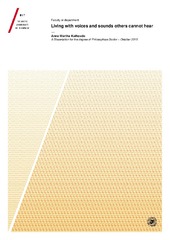Living with voices and sounds other cannot hear
Permanent lenke
https://hdl.handle.net/10037/9098Åpne
Thesis introduction and appendices (PDF)
Talseth, Gilje, and Kalhovde (2012). Voice hearing over time: A qualitative study of a woman without a psychiatric diagnosis. Also available in Open Journal of Nursing, 2012, 2, 396-405 (PDF)
Kalhovde, Elstad, and Talseth (2014). Sometimes I walk and walk, hoping to get some peace. Dealing with voices and sounds nobody else hears. Also available in International Journal of Qualitative Studies on Health and Well-being, 2014, 9: 23069 (PDF)
Dato
2016-03-31Type
Doctoral thesisDoktorgradsavhandling
Forfatter
Kalhovde, Anne MarthaSammendrag
Hearing voices and sounds unshared by others, often termed auditory (verbal) hallucinations, is commonly known as a symptom of serious mental illness. The fact that it is not uncommon in the general population has led to research focused on hearing voices and sounds as experiences in themselves. The aim of this research project was to understand how people experience hearing and dealing with voices and sounds in everyday life and over time. One person without a psychiatric diagnosis and fourteen people with a psychotic illness participated in two to three in-depth interviews. These were mainly analyzed and interpreted with a hermeneutic phenomenological approach.
The results revealed that the woman without a psychiatric diagnosis had much in common with the participants who had a psychotic disorder; they all found living with hearing voices and sounds to be recurrently upsetting. Her daily life was, however, less frequently disrupted and she did not have to deal with other mental complaints or mental health services. The participants were recurrently struck by the experiences of hearing someone; this echoed and amplified past and present experiences with others and existential magnitudes. The participants developed ways of dealing with the opposing presences and the adversity they reflected through personal trajectories: some were linear, most were circular or spiraling. Central themes encompassed: retrieving or developing their sense of having a voice and navigating health care. Being believed by someone whom the participants trusted and could talk to about their experiences was essential to becoming more confident and developing new ways of understanding and dealing with the troublesome presences.
The results challenge nurses and other health care providers to engage in participatory dialogues and thus acknowledge voice hearer’s experiences and attune their interventions and aims to the voice hearer’s perspectives. Furthermore they are challenged to address past, present and future concerns or existential matters echoed by the voices (e.g. trauma, employment or meaningful activities, spiritual and religious matters).
Beskrivelse
Paper II of this thesis is as published version not available in Munin, but available in Qualitative Health Research 23(11) 1470–1480
The accepted manuscript version is available in Munin: Kalhovde, Elstad, and Talseth (2013) Understanding the experiences of hearing voices and sounds others do not hear.
The accepted manuscript version is available in Munin: Kalhovde, Elstad, and Talseth (2013) Understanding the experiences of hearing voices and sounds others do not hear.
Forlag
UiT The Arctic University of NorwayUiT Norges arktiske universitet
Metadata
Vis full innførselSamlinger
Copyright 2016 The Author(s)
Følgende lisensfil er knyttet til denne innførselen:


 English
English norsk
norsk
